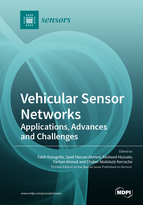Vehicular Sensor Networks: Applications, Advances and Challenges
A special issue of Sensors (ISSN 1424-8220). This special issue belongs to the section "Sensor Networks".
Deadline for manuscript submissions: closed (15 April 2020) | Viewed by 59631
Special Issue Editors
Interests: Cyber security; multimedia security; visual surveillance and hardware architectures for image and video applications; blockchain
Special Issues, Collections and Topics in MDPI journals
Interests: wireless communications; connected vehicles; named data; networks; information centric networks and ad hoc networks
Special Issues, Collections and Topics in MDPI journals
Interests: Information security and privacy; applied cryptography; vehicular ad hoc networks; blockchain; Internet of Things; named data networking
Special Issues, Collections and Topics in MDPI journals
Interests: vehicular ad hoc networks; trust management; cyber security; automotive security; secure cooperative intelligent transportation systems; cellular communication
Special Issues, Collections and Topics in MDPI journals
Interests: trust and risk management; secure multihop communications; vehicular networks; named data networking (NDN); UAVs
Special Issues, Collections and Topics in MDPI journals
Special Issue Information
Dear Colleagues,
Recent years have witnessed tremendous growth in connected vehicles due to the major interest in vehicular ad-hoc networks (VANET) technology from both the research and industrial communities. VANET involves the generation of data from on-board sensors and its dissemination in other vehicles via vehicle-to-everything (V2X) communication, thus resulting in numerous applications such as steep-curve warnings. However, to increase the scope of applications, VANET has to integrate various technologies including sensor networks, which results in a new paradigm, commonly known as vehicular sensor networks (VSN).
Unlike traditional sensor networks, every node (vehicle) in VSN is equipped with various sensing (distance sensors, GPS and cameras), storage and communicating capabilities, which can provide a wide range of applications including environmental surveillance and traffic monitoring etc. VSN has the potential to improve transportation technology and the transportation environment due to its unlimited power supply and resulting minimum energy constraints. However, VSN faces numerous challenges in terms of its design, implementation, network scalability, reliability and deployment over large-scale networks, which need to be addressed before it is realised.
This Special Issue aims to disseminate and identify areas that can increase the efficiency of various aspects of VSN. To this end, we are seeking high-quality research papers in the domain of VSN that include but are not limited to the following:
- The realization of wireless sensor networks within VANET;
- Integrating Internet-of-Things (IoT) applications within VANET and VSN;
- The impact of social networks on VANET and VSN;
- Cellular communication (4G, 5G) in VSN;
- Security and privacy issues within VSN;
- Trust management schemes for VSN;
- Cyber Security aspects of VANET and VSN;
- VANET and VSN over future internet architectures (NDN, CCN);
- Performance evaluations of VSN;
- Routing protocols for VSN;
- Testbeds and simulation tools for VSN;
- Content dissemination over VSN;
- Multimedia communications in VSN;
- Applications of blockchain within VANET and VSN.
Prof. Dr. Fatih Kurugollu
Dr. Syed Hassan Ahmed
Dr. Rasheed Hussain
Dr. Farhan Ahmad
Dr. Chaker Abdelaziz Kerrache
Guest Editors
Manuscript Submission Information
Manuscripts should be submitted online at www.mdpi.com by registering and logging in to this website. Once you are registered, click here to go to the submission form. Manuscripts can be submitted until the deadline. All submissions that pass pre-check are peer-reviewed. Accepted papers will be published continuously in the journal (as soon as accepted) and will be listed together on the special issue website. Research articles, review articles as well as short communications are invited. For planned papers, a title and short abstract (about 100 words) can be sent to the Editorial Office for announcement on this website.
Submitted manuscripts should not have been published previously, nor be under consideration for publication elsewhere (except conference proceedings papers). All manuscripts are thoroughly refereed through a single-blind peer-review process. A guide for authors and other relevant information for submission of manuscripts is available on the Instructions for Authors page. Sensors is an international peer-reviewed open access semimonthly journal published by MDPI.
Please visit the Instructions for Authors page before submitting a manuscript. The Article Processing Charge (APC) for publication in this open access journal is 2600 CHF (Swiss Francs). Submitted papers should be well formatted and use good English. Authors may use MDPI's English editing service prior to publication or during author revisions.
Keywords
- Vehicular social networks (VSN)
- Vehicular ad-hoc networks (VANET)
- Security, privacy and trust
- Cyber security
- Multimedia and cellular communication
- Emerging IoT applications in VANET and VSN
- Blockchain within VANET and VSN











